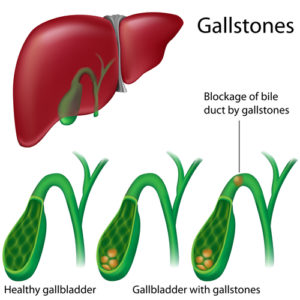 The gallbladder is an organ that is located close to the liver. The function of this organ is to concentrate the bile produced by the liver. The bile that is produced by the liver will flow into the gallbladder to be concentrated and then excreted into the duodenum (small intestine) through the bile duct.
The gallbladder is an organ that is located close to the liver. The function of this organ is to concentrate the bile produced by the liver. The bile that is produced by the liver will flow into the gallbladder to be concentrated and then excreted into the duodenum (small intestine) through the bile duct.
How do stones form in the gallbladder?
There are three types of stones in the gallbladder; cholesterol, pigment, and combinations of cholesterol and pigment. These stones form when there is imbalance between amount of bile and the cholesterol or pigment component. When there is excess cholesterol and pigment, stones will begin to form in the gallbladder.
What are the symptoms of stones in the gallbladder or gallstones?
Some of the symptoms of gallstones include:
- Pain – in the lower right ribs and heartburn. The pain feels like it is pulling and comes and go. Sometimes pain that is accompanied by nausea and vomiting is related to consumption of fatty food.
- Fever – this indicates an infection in the gallbladder that is causing inflammation (cholecystitis). If fever temperature is high followed by shivering, chills, and yellowing, this indicates an infection in the bile duct (ascending cholangitis).
- Jaundice (yellow discolouration) – can be identified through skin colour and the whites of the eyes. This is caused by presence of stones in the bile duct (choledocholithiasis)
What are the treatment options for gallstones?
Blood tests are carried out to see if there are any infections in the gallbladder, test for presence of stones, and cholesterol screening to find out the type of stones. Ultrasound will provide a visual of the stones in the gallbladder as well as identify the signs of infections in the gallbladder and obstruction due to stones in the bile duct.
If there is infection of the bile duct (ascending cholangitis) and jaundice, antibiotics will be prescribed and endoscopy to remove the stones in the bile duct.
If inflammation of the gallbladder occurs, treatment would be through antibiotics and surgical removal of the gallbladder. Emergency surgery will be carried out if the patient is unstable and shows symptoms of abscessed inflammation. Elective surgery will be done if the patient is stable and fever and blood tests carried out indicates positive response towards antibiotic treatment. The latest technology allows gallbladder surgeries to be done using laparoscopy.
Symptoms that are caused by stones in the gallbladder such as inflammation of the bile duct (ascending cholangitis), blocked bile duct (choledocholithiasis) all require surgical removal of the gallbladder. This is because the stones present in the bile duct are produced by the gallbladder.
Can I live without my gallbladder?
As the function of the gallbladder is only to concentrate the bile, its removal will not affect the food digestion process. However, patients are advised to reduce the cholesterol levels in their food intake after the removal.
Dr. Ruhi Fadzlyana is a surgeon based at a hospital in Kuala Lumpur and lectures in a local university. This article is translated from the original version at https://www.mmgazette.com/batu-di-pundi-hempedu-dr-ruhi-fadzlyana/ by Nur Nadhirah.
[This article belongs to The Malaysian Medical Gazette. Any republication (online or offline) without written permission from The Malaysian Medical Gazette is prohibited.]
